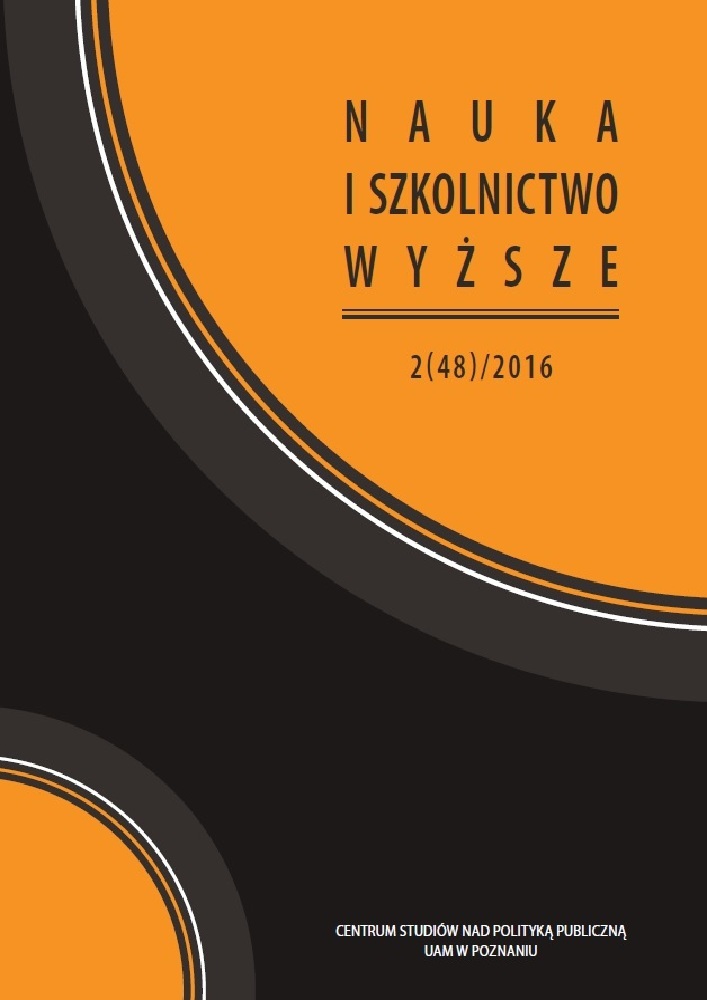Abstrakt
W artykule przedstawiono wyniki badań nad autonomią i rozliczalnością polskich uczelni publicznych w zakresie nieruchomości. Starano się w nim odpowiedzieć na pytanie: Czy w ostatnich latach uczelnie podlegały społecznej i administracyjnej kontroli poziomu wykorzystania posiadanych kampusów, a podejmowane przez nie decyzje o znacznej ich rozbudowie były ekonomicznie uzasadnione? Pytanie to ma szczególne znaczenie w dobie pogłębiającego się niżu demograficznego i zmniejszania stopnia finansowania szkolnictwa wyższego ze środków publicznych oraz rosnących kosztów utrzymania budynków. Analiza danych empirycznych pokazuje, że w okresie rozdzielania znacznych krajowych i europejskich środków publicznych na rozbudowę czy modernizację infrastruktury akademickiej uczelnie w Polsce nie były zobligowane do wykazywania, jak gospodarują powierzonym im majątkiem. W konsekwencji mogło przyczynić się to do istotnego (nie zawsze jednak uzasadnionego) wzrostu powierzchni uczelnianych zasobów, który może w kolejnych latach skutkować problemami finansowymi poszczególnych jednostek, a także determinować przyszłość całego systemu szkolnictwa wyższego.
Bibliografia
Akademiska Hus (2015). Financial information. http://akademiskahus.se/en/about-us/financial-information [20.10.2016].
AMA (2010). Guidance on the Effective Management of Space for Scotland’s colleges. https://www.webarchive.org.uk/wayback/archive/20110411223721/ http://www.sfc.ac.uk/web/FILES/ReportsandPublications/Guidance_on_the_Effective_Management_of_Space_for_Scotland%c3%a2%e2%82%ac%e2%84%a2s_colleges.pdf [20.10.2016].
Antonowicz, D., Gorlewski, B. (2011). Demograficzne tsunami. Raport Instytutu Sokratesa na temat wpływu zmian demograficznych na szkolnictwo wyższe do 2020 roku. Warszawa: Instytut Sokratesa.
APPA (2015). The APPA Facilities Performance Indicators Report. http://appa.org/research/fpi [20.10.2016].
Bladh, A. (2007). Institutional Autonomy with Increasing Dependency on Outside Actors. Higher Education Policy. 20(3): 243-259.
Bloom, D.E., Hartley, M., Rosovsky, H. (2007). Beyond Private Gain: The Public Benefits of Higher Education. W: J.J.F. Forest, P.G. Altbach (red.). International Handbook of Higher Education (293-308). Dordrecht: Springer.
Clark, B.R. (1998). Creating Entrepreneurial Universities: Organizational Pathways of Transformation. Oxford: Pergamon Press – Elsevier.
Deem, R., Hillyard, S., Reed, M. (2007). Knowledge, Higher Education, and the New Managerialism. The Changing Management of UK Universities. Oxford: Oxford University Press.
Estermann, T., Nokkala, T. (2009). University Autonomy in Europe I. Exploratory study. Brussels: European University Association.
Estermann, T., Nokkala, T., Steinel, M. (2011). University Autonomy in Europe II. The Scorecard. Brussels: European University Association.
Goedegebuure, L., Kaiser, F., Maassen, P., Meek, L., Vught, F. van, Weert, E. de (1993). International Perspectives on Trends and Issues in Higher Education Policy. W: L. Goedegebuure, F. Kaiser, P. Maassen, L. Meek, F. van Vught, E. de Weert (red.). Higher Education Policy. An International Comparative Perspective (315-348). Oxford: Pergamon Press.
GUS (2015). Szkoły wyższe i ich finanse. http://stat.gov.pl/obszary-tematyczne/edukacja/edukacja/szkoly-wyzsze-i-ichfinanse-w-2014-r-,2,11.html [20.10.2016].
Hancock, S., Hughes, G., Walsh, E. (2012). Universities and the Informal Knowledge Economy. W: P. Temple (red.). Universities in Knowledge Economy. Higher Education Organisation and Global Change (118-135). London – New York: Routledge.
Harris, J.M., Roach, B. (2013). Environmental and Natural Resource Economics. A contemporary Approach. New York: Routledge.
HEFCE (2010). Performance in higher education estates. http://www.hefce.ac.uk/media/hefce1/pubs/hefce/2011/1117/11_17.pdf [20.10.2016].
HESA (2016). Estates management record. Coverage of the record. http://hesa.ac.uk [20.10.2016].
Joroff, M., Louargand, M., Lambert, S., Becker, F. (1993). Strategic Management of the Fifth Resource: Corporate Real Estate. Norcross: Industrial Development Research Foundation.
Kaipeng, G., Juan, L. (2011). Higher Education: Public Good or Private Good? W: L. Zhang, C. Zhang, (red.). Engineering Education and Management (581-585). Berlin: Springer.
Kwiek, M. (2010). Finansowanie szkolnictwa wyższego w Polsce a transformacje finansowania publicznego szkolnictwa wyższego w Europie. CPP RPS. 16: 1-54.
Kwiek, M. (2015). Uniwersytet w dobie przemian. Instytucje i kadra akademicka w warunkach rosnącej konkurencji. Warszawa: Wyd. Naukowe PWN.
Levin, H.M. (1987). Education as a Public and a Private Good. Journal of Policy and Management. 6(4): 628-641.
Marginson, S. (2011). Imagining the global. W: R. King, S. Marginson, R. Naidoo (red.). Handbook on Globalization and Higher Education (10-39). Cheltenham: Edward Elgar Publishing.
Neave, G. (2012). The Evaluative State, Institutional Autonomy and Reengineering Higher Education in Western Europe. Hampshire: Palgrave Macmillan.
Pinheiro, R., Benneworth, P., Jones, G.A. (2012). Understanding Regions and the Institutionalization of Universities, W: R. Pinheiro, P. Benneworth, G.A. Jones (red.). Universities and Regional Development. A Critical Assessment of Tensions and Contradictions (11-32). London: Routledge.
Ranking Web of Universities (2016). Countries arranged by Number of Universities in Top Ranks. www.webometrics.info [20.10.2016].
Rogers, P.P., Jalal, K.F., Boyd, A. (2008). An Introduction to Sustainable Development. London: Earthscan.
Rybkowski, R. (2015). Autonomia a rozliczalność – polskie wyzwania. Nauka i Szkolnictwo Wyższe. 1(45): 95-115.
Rymarzak, M. (2014). University space management exemplified by selected European entities. Real Estate Management and Valuation. 22(2): 22-29.
Salmi, J. (2007). Autonomy from the State vs Responsiveness to Markets. Higher Education Policy. 20: 223-242.
Samuelson, P.A. (1954). The Pure Theory of Public Expenditure. Review of Economics and Statistics. 36(4): 387-389.
SCUP (2015). SCUP’s Campus Facilities Inventory. http://scup.org/page/resources/cfi [20.10.2016].
SMG (2006). Managing space: A review of English further education and HE overseas. http://www.smg.ac.uk/documents/FEandoverseas.pdf [20.10.2016].
Szadkowski, K. (2015). Uniwersytet jako dobro wspólne. Podstawy krytycznych badań nad szkolnictwem wyższym. Warszawa: Wyd. Naukowe PWN.
TEFMA (2009). Space Planning Guidelines, Edition 3. http://www.tefma.com/uploads/content/26TEFMA-SPACE-PLANNING-GUIDELINES-FINAL-ED3-28-AUGUST-09. pdf [20.10.2016].
Thorens, J. (1998). Academic freedom and university autonomy. Prospects. 28(3): 401-407.
Trow, M. (2007). Reflections on the Transition from Elite to Mass to Universal Access: Forms and Phases of Higher Education in Modern Societies since WWII. W: J.J.F. Forest, P.G. Altbach (red.), International Handbook of Higher Education. Dordrecht: Springer.
UNESCO (2016). Teachers in tertiary education programmes. www.data.uis.unesco.org [20.10.2016].
Verhoest, K., Peters, B.G., Bouckaert, G., Verschuere, B. (2004). The Study of Organisational Autonomy: A Conceptual Review. Public Administration and Development. 24(2): 101-118.
Wheelahan, L. (2012). Accessing knowledge in the university of the future. W: R. Barnett (red.). The Future University. Ideas and Possibilities (39-49). London – New York: Routledge.
Wojewnik-Filipkowska, A., Rymarzak, M., Lausberg, C. (2015), Current managerial topics in public real estate asset management. Świat Nieruchomości. 94: 5-10.
